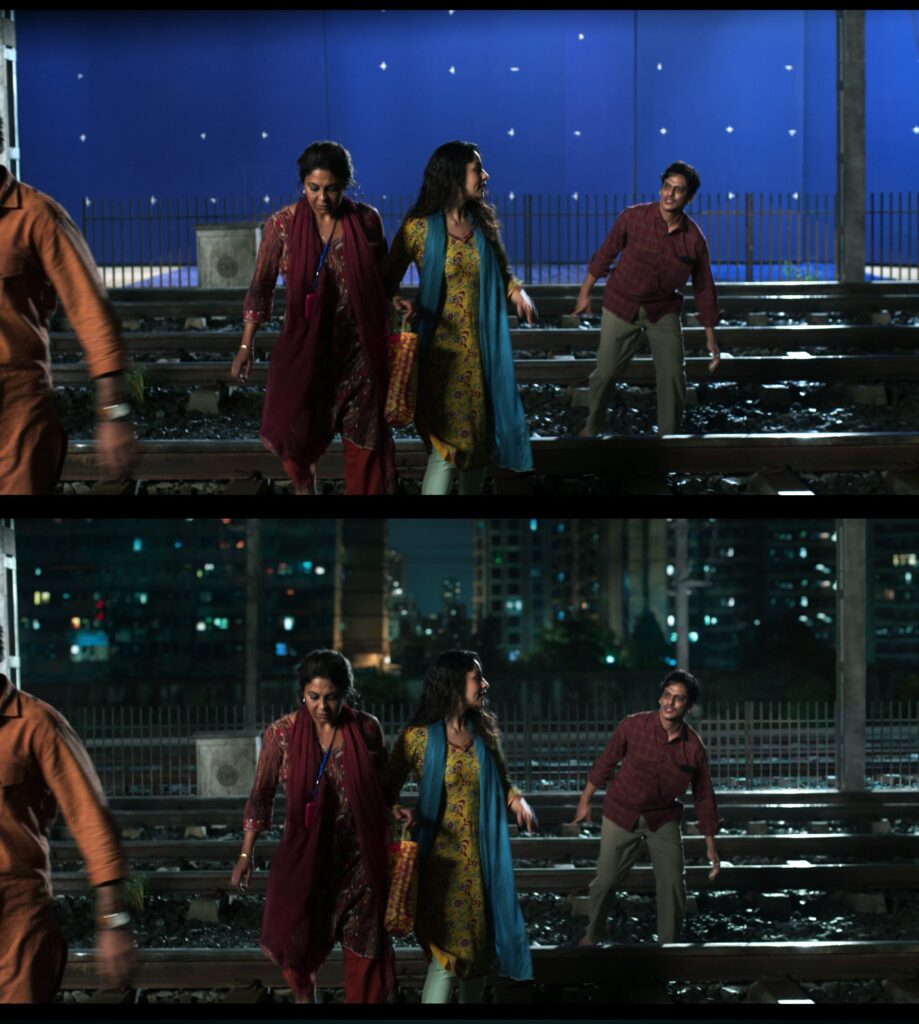
Jasmeet K. Reen’s directorial debut film Darlings stars Alia Bhatt as a young woman Badru, who takes revenge on her abusive alcoholic husband Hamza, played by Vijay Varma. Reen also co-wrote the screenplay for the film.
A nail-biting series of comic events eventually leads to a gripping showdown on a railway track, which was achieved with VFX without ever losing the sense of realism. FutureWorks delivered over 500 VFX shots for the film.
Creating the movie’s dramatic climax
The studio was brought on to deliver VFX for the film’s powerful finale. The scene involves Badru helping to tie her husband to the railway track in a bid to kill him. At this point in the story, the audience is absolutely hooked, so the train scene is designed to ramp up the tension even more before delivering the main protagonist’s death as a huge shock. With such a pivotal sequence, it was vital that it had a big impact.
As shooting at the real-life location would have been impossible, the scenes were filmed on a blue screen stage, with veteran DoP Anil Mehta at the helm. A 200-meter set was built to mimic the real-world location. The key challenge was to perfect the scene with VFX, without the audience ever doubting the realism of the sequence.
The VFX team, headed up by supervisors Vinay Singh Chuphal and Ashoke Choudhury, coordinated extensively with the direction, camera and lighting departments to ensure that all shots were planned out in advance. “Once we had everything in place, we shot the train plates used as references for animation, lighting and compositing. Shooting train plates as per chroma shots angles was not possible so we had no option but to create a CGI train,” explained VFX supervisor Chuphal.
“The previs tool was used to generate a rough plan of how the final shot would look like. This helped us visualise the final shot before production started so that everyone involved could work with clarity. The CGI team took care of creating the required train model, with all of its components correctly simulated like doors, windows, and other details,” he added.
The entire production process spanned three months, with FutureWorks developing concept art based on the storyline and storyboards of the necessary shots, provided by the assistant director. The finalised composition was then produced, based on the concept art, including the camera axes and magnification for each shot. Reference shots were captured at the real location to understand the lighting of a real railway track, while multiple photos were taken for the VFX work. These were used to help create the final Digital Matte Painting (DMP) backgrounds to be used in some of the shots. “We used the same techniques to paint out the sky and ground, which helped give our shots a sense of depth,” said Chuphal.
While building the sequence, the team – comprising more than 40 artists, including 25 comp artists and seven CGI artists – was able to check shots in the DI for colour reference. Having the DI in the studio during filming made it easier for the team to continually check the shots as they went along. The studio shots were seamlessly blended with footage filmed on location to complete the dramatic set piece while ensuring a high sense of realism throughout the entire scene.
Blending ultra-realistic VFX with real-world shots
With so many moving parts, the nighttime train sequence was very complex to put together. One of the more challenging shots involved the train passing over the camera at a 45-degree angle. As well as recreating a realistic city backdrop behind the train, the VFX team also had to produce shots of the train hitting Hamza. It was essential to achieve a photo-realistic look that blended with the rest of the film and to ensure that the VFX was effectively invisible. As such a critical part of the story, and the film, the breathtaking finale was entirely dependent on VFX to maximise the emotional impact on the audience. “Shooting with the actors on set, our VFX team captured all possible information to achieve a realistic result in the post,” said Chuphal.
He added, “Our matchmove team helped the CG team to get the perfect scale of the location, while the CGI team was also involved in setting up camera lenses and lighting conditions so that everything matched up correctly.”
After lighting, multiple passes were rendered out for the compositing team. The VFX crew added a few more touches to boost the realism, including simulated dust particles and light bleeding through the train windows. Once the CGI render was complete, DMPs and shots were keyed and composited on Nuke.
Director Jasmeet K. Reen said, “The seamless VFX work done on Darlings is incredible, and the different kinds of challenges the FutureWorks VFX team had to overcome are all very inspiring. I really enjoyed working with the team on Darlings. I don’t think we would have been able to deliver the work on time without their dedication and planning.”
FutureWorks’ CEO Gaurav Gupta said, “We’re thrilled to have worked on such an exciting project. The train sequence in Darlings is an incredible moment and we’re really proud to have helped bring one of the story’s most pivotal scenes to the screen, in the most realistic way possible.”
The dark comedy smashed records for the streaming platform, with the biggest global opening weekend for a non-English language original film, clocking up more than 10 million viewing hours in its first three days.





